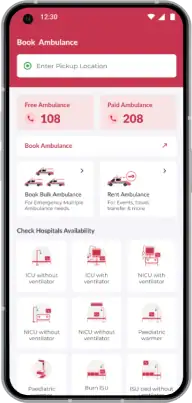In a country as vast and diverse as India, access to timely medical care can be a significant challenge, especially in remote areas or during emergencies. This is where the importance of air ambulance services becomes paramount. Air ambulances serve as a lifeline, providing rapid medical response, enhanced medical capabilities and seamless transportation to save lives when every minute counts.
Advantages of Air Ambulance Service
Air ambulance services offer several advantages that contribute to their increasing importance in India. Some of the advantages are:
Rapid Medical Response and Evacuation: Helicopter ambulance has the unique ability to reach remote and inaccessible areas quickly. Whether it's a remote village struck by a natural disaster or a critical patient in a far-flung region, air ambulances can swiftly transport medical personnel and essential equipment to provide timely medical intervention. This ability can mean the difference between life and death in emergency situations.
Enhanced Medical Capabilities: Air ambulances are equipped with advanced medical equipment and facilities, similar to those found in a hospital's intensive care unit. They are staffed with highly trained medical professionals, including doctors, nurses and paramedics, who specialize in critical care. The presence of specialized medical personnel and state-of-the-art equipment ensures that patients receive immediate and appropriate medical attention during transit.
Seamless Transportation and Accessibility: Air ambulances provide a level of transportation and accessibility that traditional ground ambulances often cannot match. They can bypass traffic congestion and overcome challenging terrains, such as hilly regions or areas affected by floods. This flexibility enables the helicopter ambulance to reach patients in remote locations swiftly, where ground transportation may not be feasible or time-consuming.
Critical Situations Where Air Ambulance Service is Vital
Air ambulance services play a crucial role in various critical situations, proving to be a vital component of India's healthcare infrastructure.
Natural Disasters and Emergencies: During natural disasters like earthquakes, floods or cyclones, where infrastructure is damaged and road access is compromised, helicopter ambulance becomes instrumental in providing immediate medical assistance. They can swiftly deploy medical teams and evacuate injured individuals, ensuring they receive timely medical care and increasing their chances of survival.
Medical Emergencies in Remote Areas: India's vast rural landscape poses challenges in providing quality healthcare to remote areas. Air ambulances bridge this gap by offering rapid medical evacuation and transportation for critical patients. Whether it's a severe accident or a medical emergency, air ambulances can quickly transport patients from remote locations to well-equipped hospitals in urban centers, saving valuable time and increasing their chances of recovery.
Organ Transplant and Intercity Transfers: Helicopter ambulance plays a vital role in organ transplantation, where time is of utmost importance. They provide efficient transportation of organs from the donor's location to the recipient's hospital, ensuring that the organ remains viable for transplantation. Additionally, air ambulances facilitate intercity medical transfers, allowing patients to access specialized healthcare facilities across different regions of the country promptly.
Air Ambulance Services in India
Air ambulance service in India has emerged as a critical lifeline for patients in need of immediate medical attention. These services are specially equipped aircraft that are staffed with highly trained medical professionals, ensuring rapid response and advanced care during transportation. With the ability to reach remote and inaccessible areas swiftly, air ambulances have revolutionized emergency healthcare across the country. They play a vital role in transporting patients with critical conditions, providing them with timely access to specialized medical facilities. These services are equipped with state-of-the-art medical equipment, including intensive care units, ventilators and monitoring systems, ensuring the highest level of care during the journey. Moreover, helicopter ambulance services collaborate closely with hospitals and emergency response teams, facilitating seamless transfers and optimizing patient outcomes. With their ability to navigate challenging terrains and significantly reduce travel time, air ambulance services have undoubtedly become an indispensable asset in India's healthcare infrastructure.
Cost of Air Ambulance Service and Accessibility
In India, the cost of air ambulance service plays a significant role in determining access to life-saving medical transportation. With the advancements in emergency healthcare, these services have become an essential component of the healthcare system. However, the expenses involved can vary depending on several factors. According to recent data, the cost of air ambulance services in India ranges from INR 2 lakhs to INR 10 lakhs or more, depending on the distance, type of aircraft, medical equipment required and the patient's condition. Factors such as landing charges, crew fees and fuel costs also contribute to the overall expenses. It's worth noting that these costs may be covered by insurance providers or government schemes in certain cases, alleviating the financial burden for patients and their families. Understanding the cost dynamics of air ambulance service is crucial for individuals and healthcare providers to ensure efficient and accessible emergency medical transportation.
Conclusion
Air ambulance services have become an integral part of India's healthcare infrastructure, particularly in situations where time plays a crucial role in saving lives. Their ability to provide rapid medical response, enhanced medical capabilities and seamless transportation makes them invaluable in emergencies, remote areas and organ transplant procedures. As India continues to develop its healthcare ecosystem, it is imperative to recognize the importance of air ambulance services and support their growth. By fostering awareness, ensuring affordability, and investing in infrastructure, we can strengthen the reach and impact of helicopter ambulance services, ultimately saving more lives from the skies.






